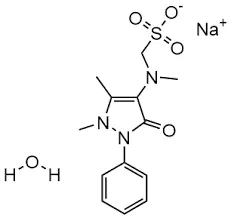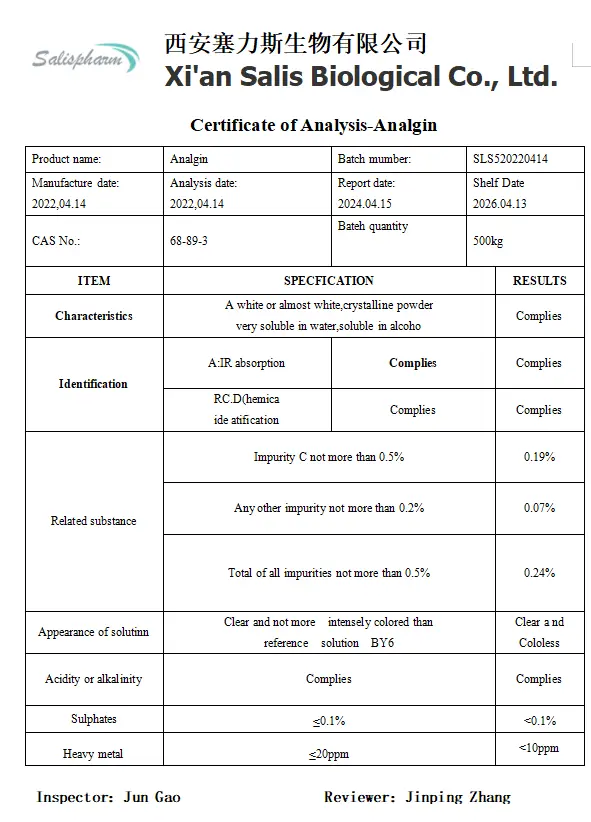Analgin powder, also known as metamizole or dipyrone, is a versatile medication widely used for its analgesic, antipyretic, and spasmolytic properties. This powerful drug has been a staple in medical practices for decades, particularly in countries where it remains approved for use. Analgin powder is primarily utilized to alleviate various types of pain, reduce fever, and manage certain spasmodic conditions. Its effectiveness and rapid action make it a popular choice among healthcare professionals and patients alike, although its availability varies significantly across different regions due to regulatory concerns in some countries.

How does Analgin powder work to relieve pain?
Analgin powder's mechanism of action in pain relief is multifaceted and complex, involving several pathways in the body. At its core, Analgin works by inhibiting the production of prostaglandins, which are key mediators of pain and inflammation. This inhibition occurs through the blockade of cyclooxygenase (COX) enzymes, similar to how non-steroidal anti-inflammatory drugs (NSAIDs) function. However, Analgin's pain-relieving effects extend beyond this mechanism.
One of the interesting perspectives of Analgin is its capacity to tweak torment discernment at both fringe and central levels of the anxious framework. At the fringe level, it diminishes the affectability of torment receptors, making them less responsive to excruciating jolts. This activity is especially useful in cases of intense torment, such as that experienced after surgery or in cases of injury. At the central level, Analgin impacts the torment handling centers in the brain and spinal rope. It upgrades the body's common pain-inhibiting frameworks, possibly by expanding the levels of neurotransmitters like serotonin and norepinephrine. This double activity at both fringe and central levels contributes to Analgin's effective pain relieving impact, making it successful against different sorts of torment, counting migraines, headaches, dental torment, and musculoskeletal pain.
Furthermore, Analgin's spasmolytic properties include another measurement to its pain-relieving capabilities. By unwinding smooth muscle tissue, it can reduce torment related with fits in the gastrointestinal tract, biliary framework, and urinary tract. This makes it especially valuable in overseeing conditions like renal colic, where the torment is regularly caused by muscle spasms. The quick onset of activity is another striking include of Analgin powder. When managed orally, it's rapidly ingested from the gastrointestinal tract, with torment help regularly starting inside 30 minutes. This quick activity makes it a favored choice for intense torment administration in numerous clinical settings. It's important to note that while Analgin is highly effective for pain relief, its use should always be under medical supervision. The dosage and duration of treatment need to be carefully controlled to maximize benefits while minimizing potential risks. Healthcare providers often consider Analgin as part of a comprehensive pain management strategy, sometimes combining it with other analgesics or treatment modalities for optimal pain control.
What are the benefits of using Analgin powder for fever reduction?
Analgin powder's effectiveness in reducing fever is one of its most valued properties in clinical practice. As an antipyretic agent, Analgin works efficiently to lower body temperature in cases of fever, providing relief and comfort to patients. The benefits of using Analgin powder for fever reduction are numerous and significant, making it a preferred choice in many healthcare settings. The primary mechanism by which Analgin reduces fever is through its action on the hypothalamus, the body's temperature regulation center. Analgin inhibits the production of prostaglandin E2 in the hypothalamus, which is responsible for elevating the body's temperature set point during fever. By doing so, Analgin effectively resets the body's thermostat to a lower temperature, initiating processes that cool the body down.
One of the key benefits of Analgin in fever management is its rapid onset of action. When administered, patients often experience a noticeable reduction in fever within 30 to 60 minutes. This quick response is particularly valuable in situations where prompt fever reduction is necessary, such as in cases of high fever in children or in patients with underlying health conditions where prolonged high temperatures could be detrimental. Another advantage of Analgin is the duration of its antipyretic effect. A single dose can provide fever relief for several hours, which is beneficial for patient comfort and reduces the frequency of medication administration. This prolonged action is especially useful in managing persistent fevers or in situations where frequent dosing might be impractical or inconvenient.
Analgin's effectiveness in reducing fever is not limited to a specific cause of fever. It has shown efficacy in managing fevers of various origins, including those associated with infections, post-surgical states, and certain inflammatory conditions. This versatility makes it a valuable tool in diverse clinical scenarios. In pediatric care, where fever management is often a significant concern, Analgin has been particularly appreciated in some countries. Its ability to rapidly and effectively reduce fever in children, when used appropriately and under medical supervision, has made it a preferred choice for many pediatricians. However, it's crucial to note that the use of Analgin in children varies significantly between countries due to differing regulatory statuses and guidelines. The dual action of Analgin as both an antipyretic and an analgesic is another benefit worth highlighting. In many cases of fever, patients also experience associated discomfort or pain. Analgin's ability to address both symptoms simultaneously can lead to improved overall patient comfort and potentially faster recovery.
It's important to emphasize that while Analgin is effective in reducing fever, its use should always be guided by healthcare professionals. Fever is often a symptom of an underlying condition, and while managing the fever is important, identifying and treating the root cause is equally crucial. Healthcare providers consider various factors, including the patient's overall health status, the cause of the fever, and potential risks, when deciding to use Analgin for fever reduction.
Can Analgin powder be used to treat menstrual cramps?
Analgin powder has gained recognition for its effectiveness in treating menstrual cramps, also known as dysmenorrhea. This application of Analgin showcases its versatility as a medication, extending beyond general pain relief and fever reduction to address a specific and common women's health issue. The use of Analgin for menstrual cramps is based on its combined analgesic and spasmolytic properties, which make it particularly well-suited for this type of pain. Menstrual cramps occur due to the contraction of the uterus during menstruation. These contractions are mediated by prostaglandins, which cause the uterine muscles to contract and can lead to pain and discomfort. Analgin's ability to inhibit prostaglandin synthesis plays a crucial role in its effectiveness against menstrual cramps. By reducing the production of these pain-inducing compounds, Analgin can significantly alleviate the intensity of cramps.
The spasmolytic effect of Analgin is another key factor in its efficacy against menstrual pain. This property helps to relax the smooth muscle of the uterus, reducing the intensity and frequency of contractions. The combination of pain relief and muscle relaxation can provide comprehensive relief from the discomfort associated with menstruation. Many women find that Analgin offers rapid relief from menstrual cramps. The quick onset of action, typically within 30 minutes to an hour after administration, is particularly beneficial for those experiencing acute pain at the onset of their menstrual cycle. This fast-acting nature allows women to manage their symptoms promptly and continue with their daily activities with minimal disruption.
Another advantage of using Analgin for menstrual cramps is its duration of effect. A single dose can provide relief for several hours, which is often sufficient to cover the most intense period of cramping. This prolonged action reduces the need for frequent dosing, making it a convenient option for many women. The effectiveness of Analgin in treating menstrual cramps has been supported by clinical experiences and some studies. Many women report significant improvement in pain levels and overall comfort during their menstrual periods when using Analgin. Some healthcare providers consider it as an alternative to traditional NSAIDs, especially in cases where other medications have not provided adequate relief or are contraindicated. It's important to note that while Analgin can be effective for menstrual cramps, its use should be under medical guidance. The appropriate dosage and duration of treatment need to be determined based on individual factors. Additionally, healthcare providers may need to consider any underlying conditions or potential interactions with other medications before recommending Analgin for menstrual pain management.
Conclusion
For women with severe or chronic menstrual pain, Analgin might be part of a broader treatment approach. This could include lifestyle modifications, hormonal treatments, or other interventions depending on the underlying cause of the dysmenorrhea. A comprehensive approach ensures that not only the symptoms are managed but also any underlying issues are addressed. In conclusion, Analgin powder represents a potent option for managing menstrual cramps, offering rapid and effective relief through its dual action as an analgesic and spasmolytic agent. Its ability to address both the pain and the muscle contractions associated with menstruation makes it a valuable tool in women's health. However, as with any medication, its use should be guided by healthcare professionals to ensure safe and appropriate application.
If you are also interested in this product and want to know more product details, or want to know about other related products, please feel free to contact lea_slsbio@163.com,WhatsApp+86 13193326505.

References
1. Nikolova, I., Tencheva, J., Voinikov, J., Petkova, V., Benbasat, N., & Danchev, N. (2012). Metamizole: A Review Profile of a Well-Known "Forgotten" Drug. Part I: Pharmaceutical and Nonclinical Profile. Biotechnology & Biotechnological Equipment, 26(6), 3329-3337.
2. Jasiecka, A., Maślanka, T., & Jaroszewski, J. J. (2014). Pharmacological characteristics of metamizole. Polish journal of veterinary sciences, 17(1), 207-214.
3. Ramacciotti, A. S., Soares, B. G., & Atallah, A. N. (2007). Dipyrone for acute primary headaches. Cochrane Database of Systematic Reviews, (2).
4. Rogosch, T., Sinning, C., Podlewski, A., Watzer, B., Schlosburg, J., Lichtman, A. H., ... & Nüsing, R. (2012). Novel bioactive metabolites of dipyrone (metamizol). Bioorganic & medicinal chemistry, 20(1), 101-107.
5. Kötter, T., da Costa, B. R., Fässler, M., Blozik, E., Linde, K., Jüni, P., ... & Scherer, M. (2015). Metamizole-associated adverse events: a systematic review and meta-analysis. PloS one, 10(4), e0122918.
6. Malvar, D. D. C., Aguiar, F. A., Vaz, A. D. L. L., Assis, D. C., de Melo, M. C., Jabor, V. A., ... & Martins, I. (2014). Dipyrone metabolite 4-MAA induces hypothermia and inhibits PGE2-dependent and-independent fever while 4-AA only blocks PGE2-dependent fever. British journal of pharmacology, 171(15), 3666-3679.

